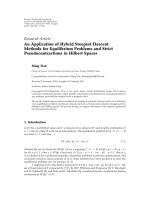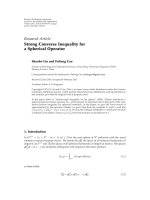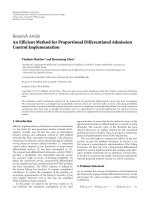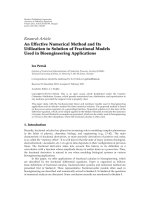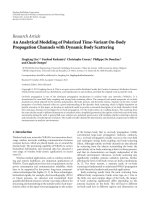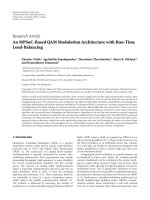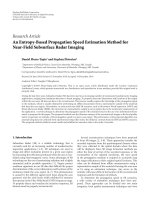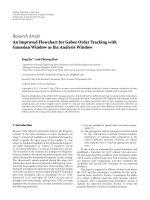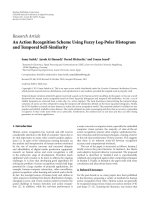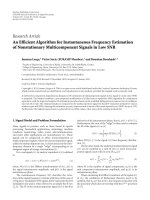Báo cáo hóa học: "Research Article An Exponential Inequality for Negatively Associated Random Variables" pptx
Bạn đang xem bản rút gọn của tài liệu. Xem và tải ngay bản đầy đủ của tài liệu tại đây (472.63 KB, 7 trang )
Hindawi Publishing Corporation
Journal of Inequalities and Applications
Volume 2009, Article ID 649427, 7 pages
doi:10.1155/2009/649427
Research Article
An Exponential Inequality for Negatively
Associated Random Variables
Soo Hak Sung
Department of Applied Mathematics, Pai Chai University, Taejon 302-735, South Korea
Correspondence should be addressed to Soo Hak Sung,
Received 15 October 2008; Revised 16 February 2009; Accepted 7 May 2009
Recommended by Jewgeni Dshalalow
An exponential inequality is established for identically distributed negatively associated random
variables which have the finite Laplace transforms. The inequality improves the results of Kim
and Kim 2007, Nooghabi and Azarnoosh 2009, and Xing et al. 2009.Wealsoobtainthe
convergence rate O1n
1/2
log n
−1/2
for the strong law of large numbers, which improves the
corresponding ones of Kim and Kim, Nooghabi and Azarnoosh, and Xing et al.
Copyright q 2009 Soo Hak Sung. This is an open access article distributed under the Creative
Commons Attribution License, which permits unrestricted use, distribution, and reproduction in
any medium, provided the original work is properly cited.
1. Introduction
Let {X
n
,n ≥ 1} be a sequence of random variables defined on a fi xed probability space
Ω, F,P. The concept of negatively associated random variables was introduced by Alam
and Saxena 1 and carefully studied by Joag-Dev and Proschan 2. A finite family of random
variables {X
i
, 1 ≤ i ≤ n} is said to be negatively associated if for every pair of disjoint subsets
A and B of {1, 2, ,n},
Cov
f
1
X
i
,i∈ A
,f
2
X
j
,j ∈ B
≤ 0, 1.1
whenever f
1
and f
2
are coordinatewise increasing and the covariance exists. An infinite
family of random variables is negatively associated if every finite subfamily is negatively
associated. As pointed out and proved by Joag-Dev and Proschan 2, a number of
well-known multivariate distributions possess the negative association property, such as
multinomial, convolution of unlike multinomial, multivariate hypergeometric, Dirichlet,
permutation distribution, negatively correlated normal distribution, random sampling
without replacement, and joint distribution of ranks.
2 Journal of Inequalities and Applications
The exponential inequality plays an important role in various proofs of limit theorems.
In particular, it provides a measure of convergence rate for the strong law of large numbers.
The counterpart of the negative association is positive association. The concept of positively
associated random variables was introduced by Esary et al. 3. The exponential inequalities
for positively associated random variables were obtained by Devroye 4, Ioannides and
Roussas 5, Oliveira 6,Sung7, Xing and Yang 8, and Xing et al. 9. On the other hand,
Kim and Kim 10, Nooghabi and Azarnoosh 11, and Xing et al. 12 obtained exponential
inequalities for negatively associated random variables.
In this paper, we establish an exponential inequality for identically distributed
negatively associated random variables by using truncation method not using a block
decomposition of the sums. Our result improves those of Kim and Kim 10, Nooghabi and
Azarnoosh 11, and Xing et al. 12. We also obtain the convergence rate O1n
1/2
log n
−1/2
for the strong law of large numbers.
2. Preliminary lemmas
To prove our main results, the following lemmas are needed. We start with a well known
lemma. The constant C
p
can be taken as that of Marcinkiewicz-Zygmund see Shao 13.
Lemma 2.1. Let {X
n
,n≥ 1} be a sequence of negatively associated random variables with mean zero
and finite pth moments, where 1 <p≤ 2. Then there exists a positive constant C
p
depending only on
p such that
E
n
i1
X
i
p
≤ C
p
n
i1
E|X
i
|
p
. 2.1
If p 2, then it is possible to take C
2
1.
The following lemma is due to Joag-Dev and Proschan 2. It is still valid for any t ≤ 0.
Lemma 2.2. Let {X
n
,n ≥ 1} be a sequence of negatively associated random variables. Then for any
t>0,
E exp
t
n
i1
X
i
≤
n
i1
Ee
tX
i
. 2.2
The following lemma plays an essential role in our main results.
Lemma 2.3. Let X
1
, ,X
n
be negatively associated mean zero random variables such that
|
X
i
|
≤ d
i
, 1 ≤ i ≤ n, 2.3
for a sequence of positive constants d
1
, ,d
n
. Then for any λ>0,
E exp
λ
n
i1
X
i
≤ exp
λ
2
2
n
i1
e
λd
i
EX
2
i
. 2.4
Journal of Inequalities and Applications 3
Proof. From the inequality e
x
≤ 1 x x
2
/2e
|x|
for all x ∈ R, we have
Ee
λX
i
≤ 1 λEX
i
λ
2
2
E
X
2
i
e
λ|X
i
|
1
λ
2
2
E
X
2
i
e
λ
|
X
i
|
since the X
i
have mean zero
≤ 1
λ
2
2
e
λd
i
EX
2
i
≤ exp
λ
2
2
e
λd
i
EX
2
i
,
2.5
since 1 x ≤ e
x
for all x ∈ R. It follows by Lemma 2.2 that
E exp
λ
n
i1
X
i
≤
n
i1
Ee
λX
i
≤
n
i1
exp
λ
2
2
e
λd
i
EX
2
i
exp
λ
2
2
n
i1
e
λd
i
EX
2
i
. 2.6
3. Main results
Let {X
n
,n ≥ 1} be a sequence of random variables and {c
n
,n ≥ 1} be a sequence of positive
real numbers. Define for 1 ≤ i ≤ n, n ≥ 1,
X
1,i,n
−c
n
I
X
i
< −c
n
X
i
I
−c
n
≤ X
i
≤ c
n
c
n
I
X
i
>c
n
,
X
2,i,n
X
i
− c
n
I
X
i
>c
n
,
X
3,i,n
X
i
c
n
I
X
i
< −c
n
.
3.1
Note that X
1,i,n
X
2,i,n
X
3,i,n
X
i
for 1 ≤ i ≤ n, n ≥ 1. For each fixed n ≥ 1,X
1,1,n
, ,X
1,n,n
are bounded by c
n
. If {X
n
,n≥ 1} are negatively associated random variables, then {X
q,i,n
, 1 ≤
i ≤ n},q 1, 2, 3, are also negatively associated random variables, since {X
q,i,n
, 1 ≤ i ≤ n} are
monotone transformations of {X
i
, 1 ≤ i ≤ n}.
Lemma 3.1. Let {X
n
,n ≥ 1} be a sequence of identically distributed negatively associated random
variables. Let X
1,i,n
, 1 ≤ i ≤ n, n ≥ 1 be as in 3.1. Then for any λ>0,
E exp
λ
n
i1
X
1,i,n
− EX
1,i,n
≤ exp
λ
2
n
2
e
2λc
n
E|X
1
|
2
. 3.2
4 Journal of Inequalities and Applications
Proof. Noting that |X
1,i,n
− EX
1,i,n
|≤2c
n
, we have by Lemma 2.3 that
E exp
λ
n
i1
X
1,i,n
− EX
1,i,n
≤ exp
λ
2
2
n
i1
e
2λc
n
Var
X
1,i,n
≤ exp
λ
2
n
2
e
2λc
n
E|X
1,1,n
|
2
≤ exp
λ
2
n
2
e
2λc
n
E|X
1
|
2
.
3.3
The following lemma gives an exponential inequality for the sum of bounded terms.
Lemma 3.2. Let {X
n
,n ≥ 1} be a sequence of identically distributed negatively associated random
variables. Let X
1,i,n
, 1 ≤ i ≤ n, n ≥ 1 be as in 3.1. Then for any >0 such that ≤ eE|X
1
|
2
/2c
n
,
P
1
n
n
i1
X
1,i,n
− EX
1,i,n
>
≤ 2 exp
−
n
2
2eE|X
1
|
2
. 3.4
Proof. By Markov’s inequality and Lemma 3.1, we have that for any λ>0
P
1
n
n
i1
X
1,i,n
− EX
1,i,n
>
P
exp
λ
n
i1
X
1,i,n
− EX
1,i,n
>e
λn
≤ e
−λn
E exp
λ
n
i1
X
1,i,n
− EX
1,i,n
≤ exp
−λn
λ
2
n
2
e
2λc
n
E|X
1
|
2
.
3.5
Putting λ /eE|X
1
|
2
, note that 2λc
n
≤ 1, we get
P
1
n
n
i1
X
1,i,n
− EX
1,i,n
>
≤ exp
−
n
2
2eE|X
1
|
2
. 3.6
Since {−X
n
,n ≥ 1} are also negatively associated random variables, we can replace X
1,i,n
by
−X
1,i,n
in the above statement. That is,
P
−
1
n
n
i1
X
1,i,n
− EX
1,i,n
>
≤ exp
−
n
2
2eE|X
1
|
2
. 3.7
Journal of Inequalities and Applications 5
Observing that
P
1
n
n
i1
X
1,i,n
− EX
1,i,n
>
P
1
n
n
i1
X
1,i,n
− EX
1,i,n
>
P
−
1
n
n
i1
X
1,i,n
− EX
1,i,n
>
,
3.8
the result follows by 3.6 and 3.7.
Remark 3.3. From 14, Lemma 3.5 in Yang, it can be obtained an upper bound
2 exp−n
2
/4E|X
1
|
2
2eE|X
1
|
2
, which is greater than our upper bound.
The following lemma gives an exponential inequality for the sum of unbounded terms.
Lemma 3.4. Let {X
n
,n ≥ 1} be a sequence of identically distributed negatively associated random
variables with Ee
δ|X
1
|
< ∞ for some δ>0. Let X
q,i,n
, 1 ≤ i ≤ n, n ≥ 1,q 2, 3, be as in 3.1. Then,
for any >0, the following statements hold:
i P 1/n|
n
i1
X
2,i,n
− EX
2,i,n
| > ≤ 2δ
−2
−2
n
−1
Ee
δ|X
1
|
e
−δc
n
.
ii P 1/n|
n
i1
X
3,i,n
− EX
3,i,n
| > ≤ 2δ
−2
−2
n
−1
Ee
δ|X
1
|
e
−δc
n
.
Proof. i By Markov’s inequality and Lemma 2.1,weget
P
1
n
n
i1
X
2,i,n
− EX
2,i,n
≤
1
2
n
2
E
n
i1
X
2,i,n
− EX
2,i,n
2
≤
Var
X
2,1,n
2
n
≤
E|X
2,1,n
|
2
2
n
.
3.9
The rest of the proof is similar to that of 12, Lemma 4.1 in Xing et al. and is omitted.
ii The proof is similar to that of i and is omitted.
Now we state and prove one of our main results.
Theorem 3.5. Let {X
n
,n ≥ 1} be a sequence of identically distributed negatively associated random
variables with Ee
δ|X
1
|
< ∞ for some δ>0. Let
n
2δeE|X
1
|
2
c
n
/n, where {c
n
,n ≥ 1} is a
sequence of positive numbers such that
0 <c
n
≤
eE|X
1
|
2
n
8δ
1/3
. 3.10
Then
P
1
n
n
i1
X
i
− EX
i
> 3
n
≤ 2
1
Ee
δ|X
1
|
δ
3
eE|X
1
|
2
c
n
e
−δc
n
. 3.11
6 Journal of Inequalities and Applications
Proof. Note that 2
n
c
n
≤ eE|X
1
|
2
and n
2
n
/2eE|X
1
|
2
δc
n
. It follows by Lemmas 3.2 and 3.4
that
P
1
n
n
i1
X
i
− EX
i
> 3
n
≤
P
1
n
n
i1
X
1,i,n
− EX
1,i,n
>
n
P
1
n
n
i1
X
2,i,n
− EX
2,i,n
>
n
P
1
n
n
i1
X
3,i,n
− EX
3,i,n
>
n
≤ 2exp
−
n
2
n
2eE|X
1
|
2
4Ee
δ|X
1
|
δ
2
2
n
n
e
−δc
n
2
1
Ee
δ|X
1
|
δ
3
eE|X
1
|
2
c
n
e
−δc
n
3.12
In Theorem 3.5, the condition on c
n
is 3.10.But,KimandKim10, Nooghabi and
Azarnoosh 11, and Xing et al. 12 used c
n
as only log n. We give some examples satisfying
the condition 3.10 of Theorem 3.5.
Example 3.6. Let c
n
log n
3
p
n
, where 1 ≤ p
n
on
1/3
/log n
3
. Then c
n
→∞as n →∞
and so the upper bound of 3.11 is O1e
−δp
n
log n
3
. The corresponding upper bound O11
n
2
/p
n
log n
3
n
−δ
was obtained by Kim and Kim 10 and Nooghabi and Azarnoosh 11.
Since our upper bound is much lower than it, our result improves the theorem in Kim and
Kim 10 and Nooghabi and Azarnoosh 11, Theorem 5.1.
Example 3.7. Let c
n
log n
3
. By Example 3.6 with p
n
1, the upper bound of 3.11 is
O1e
−δlog n
3
. The corresponding upper bound O1n
−δ
was obtained by Xing et al. 12.
Hence our result improves Xing et al. 12, Theorem 5.1.
By choosing c
n
log n and δ>1 in Theorem 3.5, we obtain the following result.
Theorem 3.8. Let {X
n
,n ≥ 1} be a sequence of identically distributed negatively associated random
variables with Ee
δ|X
1
|
< ∞ for some δ>1. Let
n
2δeE|X
1
|
2
log n/n. Then
∞
n1
P
1
n
n
i1
X
i
− EX
i
> 3
n
< ∞. 3.13
Remark 3.9. By the Borel-Cantelli lemma,
n
i1
X
i
−EX
i
/n converges almost surely with rate
3
n
−1
O1n
1/2
log n
−1/2
. The convergence rate is faster than the rate O1n
1/2
log n
−3/2
obtained by Xing et al. 12.
The following example shows that the convergence rate n
1/2
log n
−1/2
is unattainable
in Theorem 3.8.
Journal of Inequalities and Applications 7
Example 3.10. Let {X
n
,n ≥ 1} be a sequence of i.i.d. N0, 1 random variables. Then {X
n
} are
negatively associated random variables with Ee
δ|X
1
|
< ∞ for any δ. Set Z :
n
i1
X
i
/
√
n. Then
Z is also N0, 1. It is well known that P Z> ≥ 1/
√
2π1/ − 1/
3
e
−
2
/2
see Feller 15,
page 175. Thus we have that
P
⎛
⎝
1
n
n
i1
X
i
>
log n
n
⎞
⎠
2P
Z>
log n
≥
2
π
log n − 1
log n
n log n
, 3.14
which implies that the series
∞
n1
P1/n|
n
i1
X
i
| >
log n/n diverges.
Acknowledgments
The author would like to thank the referees for the helpful comments and suggestions
that considerably improved the presentation of this paper. This work was supported
by the Korea Science and Engineering FoundationKOSEF Grant funded by the Korea
governmentMOSTno. R01-2007-000-20053-0.
References
1 K. Alam and K. M. L. Saxena, “Positive dependence in multivariate distributions,” Communications in
Statistics: Theory and Methods, vol. 10, no. 12, pp. 1183–1196, 1981.
2 K. Joag-Dev and F. Proschan, “Negative association of random variables, with applications,” The
Annals of Statistics, vol. 11, no. 1, pp. 286–295, 1983.
3 J. D. Esary, F. Proschan, and D. W. Walkup, “Association of random variables, with applications,”
Annals of Mathematical Statistics, vol. 38, no. 5, pp. 1466–1474, 1967.
4 L. Devroye, “Exponential inequalities in nonparametric estimation,” in Nonparametric Functional
Estimation and Related Topics (Spetses, 1990), G. Roussas, Ed., vol. 335 of NATO Advanced Science
Institutes Series C, pp. 31–44, Kluwer Academic Publishers, Dordrecht, The Netherlands, 1991.
5 D. A. Ioannides and G. G. Roussas, “Exponential inequality for associated random variables,”
Statistics & Probability Letters, vol. 42, no. 4, pp. 423–431, 1999.
6 P. E. Oliveira, “An exponential inequality for associated variables,” Statistics & Probability Letters, vol.
73, no. 2, pp. 189–197, 2005.
7 S. H. Sung, “A note on the exponential inequality for associated random variables,” Statistics &
Probability Letters, vol. 77, no. 18, pp. 1730–1736, 2007.
8 G. Xing and S. Yang, “Notes on the exponential inequalities for strictly stationary and positively
associated random variables,” Journal of Statistical Planning and Inference, vol. 138, no. 12, pp. 4132–
4140, 2008.
9 G. Xing, S. Yang, and A. Liu, “Exponential inequalities for positively associated random variables and
applications,” Journal of Inequalities and Applications, vol. 2008, Article ID 385362, 11 pages, 2008.
10 T S. Kim and H C. Kim, “On the exponential inequality for negative dependent sequence,”
Communications of the Korean Mathematical Society, vol. 22, no. 2, pp. 315–321, 2007.
11 H. J. Nooghabi and H. A. Azarnoosh, “Exponential inequality for negatively associated random
variables,” Statistical Papers, vol. 50, no. 2, pp. 419–428, 2009.
12 G. Xing, S. Yang, A. Liu, and X. Wang, “A remark on the exponential inequality for negatively
associated random variables,” Journal of the Korean Statistical Society, vol. 38, no. 1, pp. 53–57, 2009.
13 Q M. Shao, “A comparison theorem on moment inequalities between negatively associated and
independent random variables,” Journal of Theoretical Probability, vol. 13, no. 2, pp. 343–356, 2000.
14 S. Yang, “Uniformly asymptotic normality of the regression weighted estimator for negatively
associated samples,” Statistics & Probability L etters, vol. 62, no. 2, pp. 101–110, 2003.
15
W. Feller, An Introduction to Probability Theory and Its Applications. Vol. I, John Wiley & Sons, New York,
NY, USA, 3rd edition, 1968.
